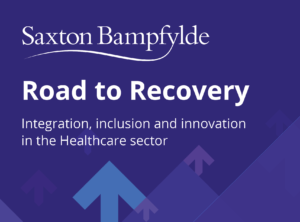
After a period of unprecedented change and challenge for the healthcare sector there is much to reflect upon to help aid recovery. In this reflection we believe that there must be a clear emphasis on learnings – what worked and what didn’t – and how these can be integrated in to delivering meaningful and people-centred models for the future.
Saxton Bampfylde is delighted to bring you a short series of interviews from senior leaders across a range of health and care settings to discuss and demonstrate the importance of learning, challenging and innovating to make a positive impact in their own organisations, and more broadly across the sector. We are very grateful to each interviewee who has generously and honestly shared their experiences and learnings with us.
#3 Interview with Richard Tyler, Chief Executive Officer, Horder Healthcare
Richard Tyler joined Horder Healthcare as Chief Executive Officer in November 2016. Richard has 30 years of healthcare experience in a wide range of settings, the last 14 of which have been at board level. Richard established, and was the first Chief Executive, of Hounslow & Richmond Community NHS Trust. He subsequently became the CEO of Queen Victoria Hospital, East Grinstead before joining Horder Healthcare.
Richard has been an elected member of the Independent Healthcare Providers Network (IHPN) Strategic Council since 2017 and has a PhD in 1960s UK industrial relations, something he feels is becoming increasingly relevant.
Richard, can you please give us an introduction to Horder Healthcare? What drew you to the organisation?
Horder Healthcare is a healthcare charity which began in the 1950s as a centre primarily for treating arthritis. It grew rapidly in the 1980s and 1990s to become an orthopaedic centre based in Crowborough. With the advent of the Blair Government and a commitment to reduce orthopaedic waiting times from 18 months to 18 weeks there was a significant opportunity for Horder. It grew very rapidly from there, working closely with the NHS. The Horder Centre in Crowborough is now one of the largest, if not the largest, single private orthopaedic centres in the country.
In 2015, Horder acquired The McIndoe Centre in East Grinstead. It is a standalone private surgery hospital on the site of the Queen Victoria Hospital where I was previously Chief Executive. The McIndoe Centre focuses primarily on plastic surgery and ophthalmology, and this is reflective of its long history, based on the pioneering work of Sir Archibald McIndoe who carried out plastic surgery at the Queen Victoria Hospital during the Second World War.
The intention for this site was to continue with plastic and ophthalmic surgery but also to do some orthopaedics and broaden the Horder brand. In parallel with the McIndoe acquisition, Horder Healthcare entered into a joint venture with another NHS organisation to provide musculoskeletal (MSK) services in East Sussex. This essentially meant managing the entire pathway from the initial GP referral. It was an innovative approach that focused on early intervention, potentially reducing the need for surgery.
I joined in 2016 when Horder had grown very quickly with both the McIndoe acquisition and the MSK joint venture. I was initially attracted to the organisation by its reputation for high quality services. I had previously worked as Chief Executive at the Queen Victoria Hospital, another specialist provider. All the evidence suggests that if you focus on one or two specialities, you deliver better outcomes and I was aware of the Horder Centre’s reputation for excellence.
The Horder Centre is a very special organisation and this was the right decision for me, and continues to be today.
The pandemic prompted a shift in the relationship between the independent sector and the NHS. What was your experience of this at Horder?
It was an interesting and challenging experience. We were one of a number of independent sector organisations who had a formal relationship with the NHS during the Covid period. We started a contractual agreement in February 2020 which ran in various iterations until 2021.
Our two sites had different functions: at the Horder Centre, because we were an orthopaedic centre, we agreed we would take people with broken hips. We don’t typically do trauma at that site but there was a view that some patients needed to be kept out of Accident and Emergency, and we were happy to provide support. At the McIndoe Centre, we had a major challenge. The Queen Victoria Hospital became a regional cancer hub for the NHS. To enable that to happen we agreed that we would take all the Queen Victoria’s trauma patients, so we turned what was primarily a private plastic surgery facility into a trauma unit focused on broken hands and facial and eye injuries. That required a major turnaround in a very short period of time.
We certainly did what we felt we could, and we wanted to utilise our surgical expertise in the best possible way to support the NHS rather than become a generic unit. The mechanics of it worked well throughout that period.
It did shift our relationship with the NHS in a positive way. Our relationship with the Queen Victoria Hospital remains very positive. Together both organisations have sustained that relationship and we now work under contract with them which helps with some of the challenges they face.
There is no doubt that working together throughout the Covid pandemic generated an enormous amount of good will on both sides. The NHS is under significant pressure at the moment and there are mixed views about how it is or should be working with the independent sector to solve some of those problems. However, I think the good will and relationships that were forged during the Covid period stand both sides in good stead to meet the current challenges.
I feel very proud of what my team did during Covid. They worked incredibly hard and moved extremely quickly. Staff were so accommodating and flexible at what was genuinely a very scary time, especially at the beginning, when we really didn’t know what was going on and how dangerous it was potentially going to be.
How is the organisation innovating to meet increased demand from both private and NHS patients?
In this last year we’ve seen a really significant increase in demand from private patients – primarily from self-pay patients – which is interesting. It is a combination of suppressed demand during Covid as surgery often wasn’t happening and there is anecdotal evidence of cohorts of people who weren’t spending. There are growing waiting lists in the NHS which will be there for a while, so we have had a huge increase in demand for private work.
To meet this demand our focus currently is threefold: ensuring the patient experience is as good as it can be; making it as easy as possible to access services via digital platforms; and aiming to innovate with, for example, robotic technology so we can enhance our surgical programme.
We are significantly upping our digital presence and investment and are looking to introduce a patient portal to allow patients to access services more directly.
We are continuing to innovate in the way we do surgery and recently we did our first robotically assisted surgery in orthopaedics. Robots are an emerging area, and this is really interesting
We remain close to the NHS and we continue to build those relationships, to support shortening waiting times and being flexible to operate quickly as and when required.
The healthcare system is changing, both in response to the pandemic and through legislation introducing new structures. What do you think the future looks like for Horder and the wider independent sector?
The NHS tends to reorganise on a regular basis, most recently with the introduction of Integrated Care Systems. In theory the ICS model makes a huge amount of sense and the principle that an ageing population requires evermore joined up health and social care is the right one.
However, the reorganisation wrapped around it takes a lot of people away from delivery at a point when we have significant waiting times which means that issue isn’t being addressed as clearly as it should be. The NHS at the moment is trying to work out what it wants to do and how it wants to do it and that brings turbulence to the system.
We do have some concerns that the ICS structures could create unnecessary barriers to joint working. We are lobbying hard to make it clear that we are a key component in the system and that we do a significant amount to help the NHS so we would rather continue to collaborate.
In the longer term pressure continues to build, particularly around waiting times, and there will be a need for more radical solutions. Organisations like the Horder are ideally placed to support, given our capacity to undertake high volumes of elective surgery. We are very open to helping but I think it is going to take a while for everything to settle down before this can happen.
Workforce is a challenge for every organisation in healthcare. What challenges are you facing, and how are you meeting those?
During the first half of last year the biggest single challenge we faced was recruiting to our clinical workforce. We had vacancies prior and during Covid and our spend on temporary staffing was significant. However, that was a challenge across the whole healthcare sector.
We have done a huge amount this year including looking at our retention packages and we are beginning to see our stability index increase. The workforce challenges are continual and our approach is continually evolving.
We are using the apprentice levy to train our own nurses; we have looked at how we can enhance our own bank staff rather than relying on agencies; and finally, we are recruiting from overseas. We have the first tranche of nurses arriving in September which is hugely exciting.
We are in a much better place than we were, and the second half of the year is likely to be dominated by the cost-of-living crisis and energy prices. However, we continue to look at maintaining and supporting our workforce.
What this experience has made us recognise is that we must continually re-evaluate how we sustain our workforce and retain and value people. To this end we are looking at much more peer recognition with long service awards, internal development programmes, and wider recognition across whole cadres of staff, engaging people in the organisation and their own development.
Download a PDF version of the interview
